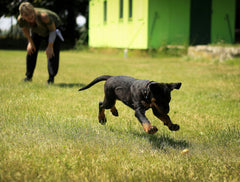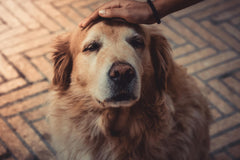
The Maine Coon is a glorious cat. Its size alone is enough to make your jaw drop as it is the largest domesticated cat breed. Aptly named, the Maine Coon comes from the state of Maine. Legend has it that Marie Antoinette, before her execution, loaded up a ship with all of her prized possessions - one of which was a Siberian or Turkish Angora cat. The captain of that ship navigated to Maine. Once in Maine, the cat bred with some other shorthairs. Their offspring evolved into the modern Maine Coon cat that we all love. It's a remarkable story for a noteworthy cat. The Maine Coon characteristics are unlike any other breed.
Here are five incredible characteristics of the Maine Coon cat that you need to know!
About Maine Coon Cats... Look At Their Size!

The first of the Maine Coon characteristics is the one you'll undoubtedly notice the fastest - their size. Male Maine Coon cats weigh between 13 to 18 pounds and can reach a length of up to 38 inches. They're also between 10 and 16 inches tall. These are big cats.
In 2010, the Guinness World Records accepted a purebred cat named Stewie as the physically biggest Maine Coon ever. This cat was a whopping 48 inches long (four full feet!) from the end of its nose to the tip of its tail. No other breed of domesticated cat has ever been that big!
They Have a Welcoming Personality

Cats have a reputation for being standoffish and aloof. Not Maine Coons, though! These dog-like cats have a warm, welcoming personality that enjoys meeting new people and trying new things. Maine Coons love nothing more than to spend some time with friendly humans. Despite their friendliness, though, most Maine Coons are not lap cats. They like being near humans but not necessarily on top of them.
Maine Coons Don't Finish Growing Until They're Three

Because of their substantial size, Maine Coons aren't like other cats in many ways. Most cats finish growing by the time they're about a year old. However, Maine Coons need about three years to reach full height, weight, and length. Therefore, if you pick up a Maine Coon kitty, there's a good chance that it still has a way to go before it becomes its full adult size.
There Are Many Types of Maine Coon Cats

When people see Maine Coons they might think that there's only one type of Maine Coon (kind of like the rigid definition of a Siamese cat). However, that's not true! Maine Coon cats come in all different colors. Some Maine Coons are solid colored, others are tabbies, while others have a darker fur pattern. Every Maine Coon is different, so if there's a particular look that you want your cat to have, you'll likely be able to find it with this type of cat.
This relatively unique characteristic is what makes Maine Coons so versatile and sought after. The fact that they can be purebred and still be different colors makes finding the right cat much easier!
Some Maine Coon Cats Have Six Toes

Cats, much like humans, have five toes on each paw. However, Maine Coons can have six toes, thanks to an unusual genetic mutation that seems to have occurred right around when these cats were first populating in the United States.
Nowadays, the sixth toe presence is "undesirable" for breeders, so it is getting harder to find Maine Coons with this fascinating genetic quirk. However, they still exist in the world.
A Maine Coon kitty or full-grown cat with six toes is not better than one with five. Both cats will have the same level of function and mobility. The only difference is that the sixth toe presence can lead to some minor issues later on in life. It's most definitely one of the more intriguing Maine Coon characteristics that many people miss looking for when they go looking to get one of these pets!
Maine Coon Characteristics: Most of Them Are Excellent!

Most Maine Coon characteristics are desirable. They love humans so much, and they are big and fluffy, which makes them ideal pets for most people. They even have some fun characteristics that you won't find on any other pet, like the possibility of having six toes.
If you're interested in a friendly, charming cat that acts a little more like a dog than a feline, consider trying a Maine Coon. There's a good chance that it is just the pet for which you're looking!




